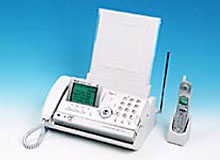HOME PHONES GOING ONLINE:
L-Mode Will Enable Direct Internet Access
January 26, 2001
|
 |
|
The L-mode phone is hoped to spark a resurgence in sales of fixed-line phones.
|
NTT East and NTT West, the local communications operations of the NTT group, will launch a new service in spring 2001 offering direct access to the Internet via fixed-line telephones. The service, to be called L-mode, will follow on the heels of the highly successful i-mode, a mobile-phone Internet-access service inaugurated in February 1999 by NTT DoCoMo, another arm of the NTT group. NTT is hoping that L-mode will spark a resurgence in sales of fixed-line phones, which have leveled off amid the soaring popularity of i-mode-equipped mobile phones.
L-Mode Controlled via Standard Phone Keys
The "L" in "L-mode" stands for living, lady (the system offers a wide range of services for women), local, and the phones' large screen and buttons. L-mode will operate on specially designed fixed-line phones equipped with liquid crystal screens. To connect to the Internet, users will press the phone's "L" button. They will then be presented with a menu of options enabling them to do their banking, secure ticket reservations, and catch up on the news, among other things, as well as send and receive e-mail. Users with L-mode phone/fax units will be able to print out the information they receive.
Among L-mode's special features is the fact that commands and messages will be input using a standard push-button phone keypad, rather than the miniature keypad featured on mobile phones, so that people of all ages will be able to use it with ease. The service will offer community-based content, such as information on sales at local stores, events at local schools, and local government services.
NTT East and NTT West have set the basic usage fee for the L-mode service at less than 500 yen (4.35 U.S. dollars at 115 yen to the dollar) per month, though separate connection charges will also apply. The two firms expect to enlist a combined total of 1.5 to 2 million L-mode subscribers during fiscal 2001 (April 2001 to March 2002). As of March 2000, Japan's 55.44 million fixed-line phones were outnumbered by the 56.84 million mobile phones in use (including both cellular phones and PHS units). Its backers regard L-mode as a crucial tool in the campaign to reverse this imbalance.
Supply of Internet Addresses Set to Multiply
Given the increasing number and variety of devices connecting to the Internet--first computers, then mobile phones and other hand-held devices, now L-mode phones, and before long, even household appliances--there is a risk that the supply of Internet addresses may run out. All of the information transmitted via the Internet has to carry the address of the
destination, just like a letter. Mechanisms such as routers handle the flow of information online by reading the address and sending the data on its way to the proper destination, but the technology currently used to manage Internet addresses, known as IPv4 (Internet Protocol version four), can only generate a maximum of 4.3 billion addresses. This is simply not enough to accommodate the more than 6 billion people on earth.
Recently, though, a new version of the Internet Protocol has been developed. The new version, IPv6, can generate many more addresses than the current version can--64 x 1027 times as many, in fact. In the near future IPv6 is expected to be adopted as the global standard. At that point, the supply of Internet addresses will be replenished, with no imaginable prospect of ever running out.
Back to Main Index
 Copyright (c) 2001 Japan Information Network. Edited by Japan Echo Inc. based on domestic Japanese news sources. Articles presented here are offered for reference purposes and do not necessarily represent the policy or views of the Japanese Government. Copyright (c) 2001 Japan Information Network. Edited by Japan Echo Inc. based on domestic Japanese news sources. Articles presented here are offered for reference purposes and do not necessarily represent the policy or views of the Japanese Government.
|



















